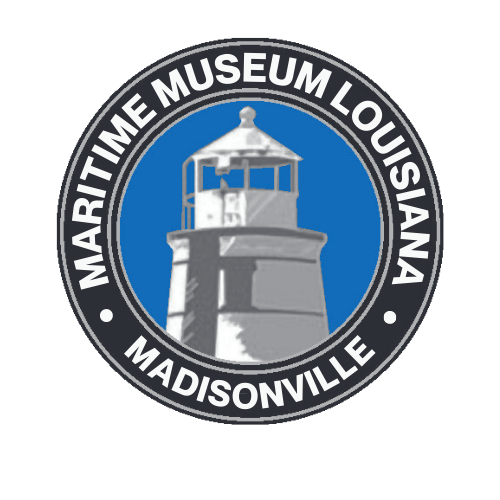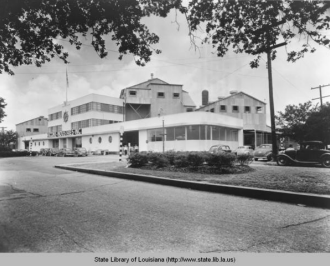Andrew J. Higgins & Higgins Boats - Part B
Having established the viability if not excellence of his boats-landing crafts and PT boats- to the U.S. Military, Higgins’ challenge was now to ramp up a massive manufacturing infrastructure to produce and deliver the boats for the Allied war effort at an accelerated rate.
Starting from a single plant with 75 employees, Higgins Industries subsequently expanded to multiple plants with over 20,000 workers by late 1943. The plants represented the first fully integrated workforce of women and men both whites and African Americans in New Orleans. Further, all workers in a given job classification were paid exactly the same wage. The job classifications were likely defined by required skill and skill level, so workers with advanced skills and skill levels received greater compensation. Shown in the foreground of the photo to the left, is the headquarters of Higgins Industries at its City Park Plant in the 1940s. At the time, the plant was the largest facility of its kind in the world.
In order to achieve the level of production of landing craft and PT boats for the Allied WWII effort, Higgins Industries operated five plants- four in New Orleans and one in Houma, LA. The New Orleans plants were the: St. Charles Avenue Plant; City Park Plant; Industrial Canal Plant; and Michoud Plant. (Note: I found another source that listed seven plants: City Park Plant; Delassize Plant; Florida Plant; Gentilly Plant: Michoud Plant; New Orleans Plant; and VoughtSikorsky Plant.)
The original plant of Higgins Industries was located on St. Charles Avenue between Felicity and Polymnia Streets. The plant was reasonably close to the Mississippi River but a considerable distance from Lake Pontchartrain. Landing craft and PT boats built during the early stages of the company’s massive expansion and building efforts were built at the St. Charles Avenue Plant. Upon completion, the vessels were trucked to and launched into Bayou St. John which provided access to Lake Pontchartrain for testing. Upon completion of the testing phase, the vessels were returned to Bayou St. John for shipment by rail to their specific destinations. In May of 1941, Higgins Industries received one of its first orders- an order for 50 LCMs by the U.S. Marine Corps. This date was in advance of the declarations of war against both Japan and Germany in December 1941, so these vessels were likely targeted for delivery to Great Britian and the Soviet Union in response to the Lend-Lease Act passed March 11, 1941. The scope of the work and the compressed time frame forced some of the work to be undertaken on a section of Polymnia Street. In an attempt to protect workers from the elements, tarps were suspended across the street from the tops of adjacent buildings. While an inconvenience to local residents, they tolerated the inconvenience because they understood the importance of the work. Plus, some of the nearby residents possibly worked at the plant. Reportedly, the final assembly was completed in a nearby vacant stable. The St. Charles Avenue Plant was closed in March 1942 resulting in the work being moved to the City Park Plant. Later, some work was transferred to the Industrial Canal Plant that was under development at the time of the March 1942 relocation. The Higgins Industries headquarters was subsequently transferred to the City Park Plant in September 1942.
This is speculation on my part but seemingly anticipating the ultimate entry of the United States into WWII and its corresponding need for a variety of vessels, Higgins purchased the Albert Weibien Marble and Granite Works Plant in July 1940. It is noted that this action corresponded almost exactly with the date of the Two-Ocean Navy Act of July 19, 1940, that increased the size of the U.S. Navy by 70 %. Certainly, debate on this Act took place some months earlier than the date of passage of the Act. Another possible indicator of the ultimate entry of the United States into the war was the implementation of the first peacetime draft in the United States on September 16, 1940. Recall that the Higgins Industries landing craft was tested in a major fleet landing exercise in February 1939. Further, there was a national debate underway as to whether the US would remain on the sidelines or become a partner in the war effort. So, in my judgment, there is a lot of indirect, if not direct evidence, that the United States would likely join the Allied WWII effort. Higgins converted the Marble and Granite Works into the largest boat building facility under one roof. This circumstance and the other factors noted previously likely motivated Higgins to expand his manufacturing capabilities. Using an assembly line much like that of the auto industry, both PT boats and landing craft were constructed on the second floor of the plant. Upon completion, the vessels were transferred by elevator to ground level and moved to Bayou St. John via truck or rail, in some cases for final assembly, but in all instances for testing in Lake Pontchartrain after which they were returned to the bayou and shipped out via rail.
Today, the Delgado Community College Administration Building and parking lot occupy the original site of the Albert Weibien Marble and Granite Works Plant. A relatively inauspicious historical marker identifies the college site as that of the Higgins Industries City Park Plant. The inscription on the marker reads:
“On this site between August 1941 and August 1945, the City Park Plant of Higgins Industries, Incorporated mass produced more than 12,000 landing craft and approximately 200 PT boats for the Allied Forces. The Higgins landing boats revolutionized modern warfare. An invading army could transport thousands of men and hundreds of tons of equipment swiftly through the surf to less-fortified beaches, thus eliminating the need for established harbors. The boats built on the site made D-Day landings at Normandy and the landings at Iwo Jima, Guadalcanal, Tarawa, Okinawa, and thousands of lesser-known assaults possible. These same craft were later used in the Military conflicts in Korea and Vietnam.”
At the peak of Higgins Industries production of military vessels, the company had more than $350,000,000 (almost 6 billion in 2023 dollars!) in government contracts, making them one of if not the world’s largest manufacturers at that time. Higgins Industries won the Army-Navy Award five times for their Industrial Canal, City Park, and Bayou St. John Plants. The “E” Award was an honor presented to companies during WWII whose production facilities achieved “Excellence in Production.” At the conclusion of WWII, the award had only been earned by 5% of the more than 85,000 companies producing materials for the war effort. Shown above is a photo of Higgins accepting the company’s fifth “E” Award from senior U.S. Navy personnel in 1945.
Whereas there is some speculation concerning the actual distribution and numbers of specific vessels that constitute the military vessels produced by Higgins Industries during WWII, the company recorded the number to be 20,094- an astounding total over basically a 5-year period! That amounts to 11 vessels/day, 365 days a year for 5 years.
Very few of these vessels still exist. Thankfully, the WWII Museum in New Orleans displays a reproduction of a LCVP built according to the original plans and with a totally volunteer workforce, some of whom worked for Higgins Industries during the War. The Museum also fully restored a PT Boat (PT-305) that is the “world’s only fully restored combatveteran PT boat in operation.” However, the Museum no longer offers Lake Pontchartrain excursions on PT-305. But rather than concluding this brief on two examples of the massive production of WWII naval vessels by Higgins Industries in the fiveyear period, 1941-45, let’s reflect on the genius of Andrew Higgins and his contributions to the WWII allied war effort. It’s remarkable that Higgins possessed both the technical skills that contributed to the design of effective naval vessels as well as the managerial skills to conceive and implement a production facility and process to manufacture naval vessels in such an efficient and productive manner. Following the announced surrender of the Japanese on August 15, 1945, ship building by Higgins Industries effectively ended in October of that year. What manufacturing efforts that continued were negatively impacted by worker unionization efforts, strikes, and loss of government contracts forcing Higgins to sell off most of his plants. Unfortunately to date, I’ve not been able to locate any significant details about Higgins’ life and activities subsequent to 1945. Sadly, Higgins died as the result of a stroke on August 2, 1952, shortly before his 66th birthday.
In honor of one of their native sons, there is an Andrew Jackson Higgins National Memorial located near the Loup River in Columbus, Ohio. There is a similar memorial to Higgins at Utah Beach, Normandy, France.









